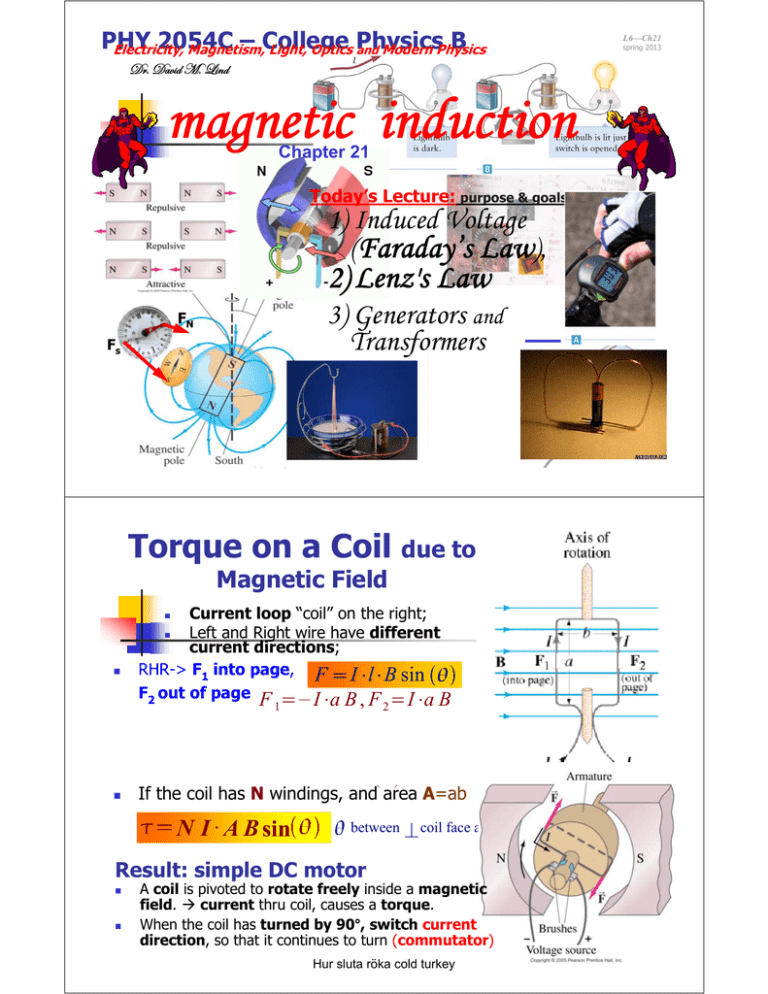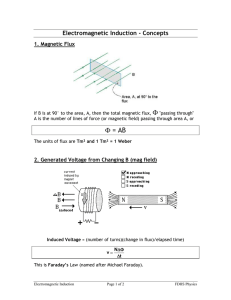Document
advertisement

PHY 2054C – College B Electricity, Magnetism, Light, Optics Physics and Modern Physics L6—Ch21 spring 2013 WÜA Wtä|w `A _|Çw magnetic induction Chapter 21 Today’s Lecture: purpose & goals 1) Induced Voltage (Faraday’s Law), 2) Lenz's Law 3) Generators and Transformersq,vF FN Fs q,v F R B Torque on a Coil due to Magnetic Field Current loop “coil” on the right; Left and Right wire have different current directions; RHR-> F1 into page, F I l B sin F2 out of page F I a B, F I a B 1 2 b F 1 sin 2 I a b B sin b F 2 sin 2 If the coil has N windings, and area A=ab N I A B sin between coil face and B Result: simple DC motor A coil is pivoted to rotate freely inside a magnetic field. current thru coil, causes a torque. When the coil has turned by 90°, switch current direction, so that it continues to turn (commutator) Hur sluta röka cold turkey q,v Very Simple Motors ….including Michael Faraday’s first demonstration of motion induced by the flow of current wire …feels a force! outward I B Strong magnet Important Points from last Lecture “First” RightHand Rule 1) Magnetic Fields are generated by moving charges, currents straight wire: B 2 I , r 0 4 q v B sin Force on current F 7 T m A N I 0 l 2) Effect of Magnetic Field; Force on moving charges F 10 current in long coil: B 0 I l B sin Torque on coil area A “Second” RightHand Rule N I A B sin Intro: Induced Voltage Michael Faraday thought: “If current produces a magnetic field, why can't a magnetic field produce a current?” When switch is closed, coil X builds up a magnetic field in magnet core Galvanometer shows negative current through coil Y When switch is opened, the magnetic field disappears, and a positive current is shown [Notice that the effect is transient; it only happens for a short time right after the opening or closing] Intro: Induced Voltage “Faraday’s Law” Inserting a magnet into a coil also produces an induced voltage (ind) or current. ind N t [the key here is change!!] The faster speed of insertion/retraction, the higher the induced voltage. What we change here is called the “magnetic flux”, the amount of field B that passes through an area A: B A cos Magnetic Flux, cont. If the field is perpendicular to the surface, B = B A If the field makes an angle θ with the normal to the surface, B = B A cosθ If the field is parallel to the surface, B = 0 “How strong the magnetic field is in that region of space” Section 21.2 Faraday’s Law, Summary Only changes in the magnetic flux matter Rapid changes in the flux produce larger values of emf than do slow changes The magnitude of the emf is proportional to the rate of change of the flux If the rate is constant, then the emf is constant This dependency on frequency means the induced emf plays an important role in AC circuits In most cases, this isn’t possible and AC currents result The induced emf is present even if there is no current in the path enclosing an area of changing magnetic flux ind changing BAcos ind N t V =IR ind ind B 0 N I l Section 21.2 Lenz's Law Sometimes it is hard to figure out the sign of the induced voltage; There is a simple rule: A change in flux gives rise to an induced current whose magnetic field always opposes the original change. (No formula) – this is the minus sign ind N t in Faraday’s law At the time of closing the switch B2 Primary current ind ind N t ΔB1 V Induced Current ind =IR Opposite directions!! B ind N I 0 l Lenz's Law2 and Example “Eddy Currents” “Induced current opposes the change that caused it” dropping a strong magnet through a copper tube: Induced Current S Induced currents - B above act attractively N Induced current's - B below magnet act repulsively Magnet will fall, but very slowly! Induced Current Question 1 ew vi e R If we send the same magnet through a pipe with a slit along the side, we would expect the magnet to a) fall at the same, slow rate as in the solid pipe b) fall even slower c) fall much faster Lenz's Law Sometimes it is hard to figure out the sign of the induced voltage; There is a simple rule: A change in flux gives rise to an induced current whose magnetic field always opposes the original change. (No formula) – this is the minus sign ind N t in Faraday’s law At the time of closing the switch B2 Primary current ind ind N t V ΔB1 Induced Current ind =IR Opposite directions!! B N I 0 l ind Question 1 When do you expect to see the lightbulb turn on? lightbulb a) when it’s at the top b) when it’s at the bottom c) on one side or the other solenoid coil pole face of magnet Anything special about the lightbulb flash? a) it turns on a very short time b) it turns on twice per revolution c) it stays on for most of the revolutuion Lenz’ Law Lenz's Law: An induced emf gives rise to a current whose magnetic field opposes the original change in magnetic flux. Magnetic Flux is reduced, Induced current tries to add to Flux Magnetic Flux is increased, Induced current tries to reduce Flux The direction of the induced current comes from “right-hand rule”1: fingers: curled B, thumb: I: Problem Solving with Lenz’s Law Lenz's Law: An induced emf gives rise to a A current cos in whose magnetic field opposes the originalBchange magnetic flux. B A cos ind Four steps: indof theNMagnetic Flux? What is the direction t N t [Out of North magnetic pole, into South magnetic pole.] Is the flux through the loop increasing or decreasing? Apply Lenz’s Law if increasing, induced field will be in opposite direction of original field. if decreasing, induced field will be in same direction as original field. I What direction will current be flowing around loop? B Use 1st RHR (out) Electric Guitars An electric guitar uses Faraday’s Law to sense the motion of the strings The string passes near a pickup coil wound around a permanent magnet As the string vibrates, it produces a changing magnetic flux The resulting emf is sent to an amplifier and the signal can be played through speakers Reading computer memory Magnetic read-heads on computer harddrives and magnetic cassette tapes sense information stored in magnetic domains this same way!! The voltage generated in the pickup coil is caused by the changing magnetic flux at the boundaries between north and south-facing magnetic domains Section 21.7 Bicycle Odometers An odometer control unit is shown, which receives signals from a pickup coil mounted on the axle support A permanent magnet is attached to a wheel that passes the coil with each wheel revolution. When the magnet passes over the pickup coil, it changes the magnetic flux thru the coil, and a pulse is generated A computer keep tracks of the number of pulses Road Traffic Sensors works similarly: a pickup coil is buried in the roadway When the ferrous parts of a car (or currents from the car’s electrical circuits) pass over the coil, a pulse is generated that records the arrival of the car ; only moving cars sensed!! Section 21.7 Faraday's Law of Induction The induced Voltage (emf ε) in a coil is winding number N times the change of the magnetic flux through the coil per time; ind N t where the magnetic flux is defined as the magnetic field B passing through a loop of area A B A cos The angle θ is measured between the normal direction of the area and the magnetic field direction Changing the Flux B A cos ind N t The magnetic flux is given by a product of B, A and cos(θ). Therefore there are three ways of creating a change in flux and therefore an induced emf. a) changing A b) changing B c) changing cos(θ) Changing cos(θ) B Acos Turning a coil in a magnetic field: Only cos(θ) changes ind ind B A cos t cos NBA t NBA 0 N this induces an AC voltage in the coil. Electric Generator Electric Generator: A permanent (or electro)magnet (rotor) with many poles is rotating through many loops of wire. The rotation keeps changing the flux through each of the stationary (stator) coils, which induces voltage on the output. When we use the voltage by drawing a current, the magnetic field of the induced current acts like a brake! (it’s removing energy!!) Motor-Generator An electric motor sends a current through a coil in a magnetic field, which starts to turn. Electrical Mechanical energy energy A generator turns a coil in a magnetic field, which produces current. Mechanical Electrical energy energy Every motor is a generator and vice versa Question 2 A generator, which is being turned by a hand-crank is hooked up with a switch to a light bulb. When the switch is closed, the cranking of the generator a) gets harder b) does not change c) gets easier Transformers Transformers are devices that can increase or decrease the amplitude of an applied AC voltage A simple transformer consists of two solenoid coils with the loops arranged so that all or most of the magnetic field lines and flux generated by one coil pass through the other coil Section 22.9 Changing B B Acos Primary winding uses AC current and voltage secondary winding produces AC current and voltage What are the voltages? ,V P N P t VS NS VP NP What are the currents ? B NS I S , B NP I P B B t IS IP Voltage VS NS B NP NS primary secondary Current primary The electric power is the same in and out! NS NP secondary VP I = V P I P = PP PS = V S I S NP NS P This assembly is called a transformer. It allows us to change voltages of AC without losing power! Question The primary winding of an electric train transformer has 400 turns, and the secondary has 50. If the input voltage is 120 V(rms), what is the output voltage? 1. 2. 3. 4. 480 V 60 V 15 V 10 V Changing B B Acos Primary winding uses AC current and voltage secondary winding produces AC current and voltage What are the voltages? B B ,V P N P t t VS NS VP NP What are the currents ? IS B NS I S , B NP I P IP somewhat idealized: Voltage VS NS B primary secondary NP NS Current primary (the total magnetic flux thru the primary coils doesn’t all pass thru the secondary): efficiency e (fraction of flux actually transferred) real transformers: IS IP e NP NS secondary VS VP e NS NP Stay tuned. . . . Wednesday: problem solving (Chs. 21): Magnetism and Induction Friday: Chapter 22 Electromagnetic Waves http://www.physics.fsu.edu/courses/summer2010/phy2054 c How do you like my magnetic personality!! Another Faraday Experiment A solenoid is positioned near a loop of wire with the lightbulb He passed a current through the solenoid by connecting it to a battery When the current through the solenoid is constant, there is no current in the wire When the switch is opened or closed, the bulb does light up Section 21.1



